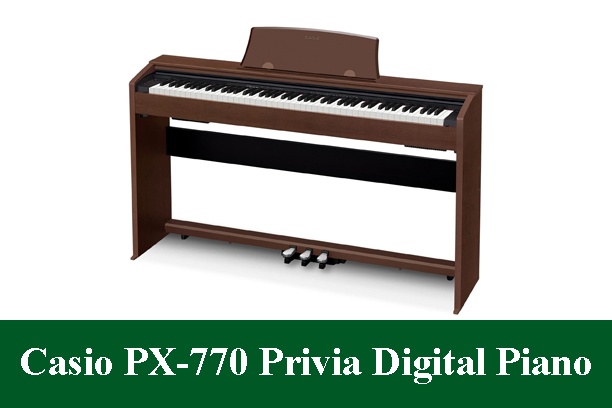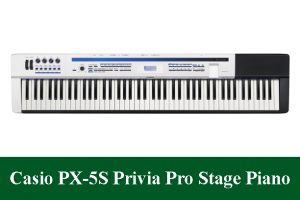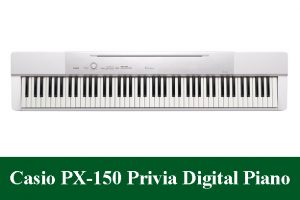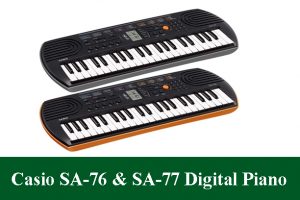Casio PX-770 Privia Digital Piano Review (Updated)
The Casio PX-770 joins the thin, modernized design of a digital piano with the sound and feel of a genuine amazing piano. Its exquisite, furniture-style bureau incorporates a sliding keyboard cover, music stand and – simply like a genuine piano – three inherent pedals (damper, delicate and sostenuto).
Combined with its generally low sticker price (can be found for about $700 online), the PX-770 gives a minimal effort piano playing knowledge that is perfect for relative apprentices intrigued by getting a digital piano that is beyond what function and one they can without a doubt develop with.
In this survey, I’ll separate what I like and abhorrence about the Casio PX-770. We’ll cover everything from figuring out how to play piano on the PX-770, to what you can anticipate from the keys (i.e. how practical do they feel?) and sound quality.
With the end goal to all the more likely help you, if it’s not too much trouble see the intuitive table underneath, which will enable you to rapidly contrast the Casio PX-770 with other significant digital pianos available.
Instruct, Learn, Play the Casio PX-770
The Casio Privia PX-770 is maybe one of the best 88-key digital pianos available for those inspired by an ease digital piano. The PX-770 joins practical feel and touch keys, astounding sound, different overhauled instrument voices and a smooth, lightweight design at a moderate cost.
From keyboard dilettante to genuine learner, the Casio PX-770 makes figuring out how to play simple with its novel two part harmony/lesson mode. Ideal for double playing, the two part harmony mode parts the keyboard into two indistinguishable parts with the equivalent correct octave go, imitating the understudy instructor/double piano situation. This feature is obviously especially incredible in case you’re searching for one of the best learner digital pianos you can purchase.
The Casio PX-770 likewise accompanies a 60-song worked in playback as well as backup library, and has the ability to alter with space for an additional 10 songs. Ideal for concurrent play, the PX-770’s 60-song prearranged song library has the option to back off or accelerate the beat of every song, enabling players to play along with the music at their very own pace. The PX-770 likewise has the ability to tweak the song library, with void openings for 10 additional songs of the player’s decision.
The PX-770 enables players to record and play-back their own exhibitions with its on-board two-track MIDI recorder and optional metronome, too. The digital piano additionally has two (2) headphone jacks for calm playing and playback.
Genuine Feel Piano Experience
The PX-770 offers 88 full-measure, scaled sledge action keys which are splendidly weighted for genuine great piano playing action. The weight and depression of the keys is flawless to those of a genuine piano. Given its smaller size, the Casio PX-770 consummately matches a smooth design with a full-sized 88-key keyboard, giving the player an extremely common, extraordinarily sensible piano playing knowledge.
Taking a seat at the Casio PX-770 digital piano felt as near taking a seat at an acoustic piano as I have ever experienced. With regards to genuine feel play, the PX-770 couldn’t get a lot nearer to the real thing. From the 88-key range and touch-delicate, scaled mallet action keys to the Acoustic and Intelligent Resonator (AiR) processor, Casio absolutely won’t frustrate any fans that favorsd the past model—the PX-760.
Much like that of its forerunner, the aforementioned Casio PX-760, the more up to date PX-770 features Tri-Sensor II Scaled Hammer Action piano keys for practical key-action. The gauged keys discourage and respond simply like those of a concert-style piano. Each key is touch-touchy, so players can expand the heaviness of their touch for a more intense, bolder fortissimo stable, or diminishing the heaviness of their touch for a gentler, milder pianissimo stable.
The weight and touch affectability of the scaled mallet action keys is uncanny. I’m not the slightest bit going to recommend that the PX-770 is likened to playing on an exceedingly costly acoustic piano, yet I will state that, given the critical contrast in expense between the PX-770 and an acoustic piano, it’s very astonishing how shut the keys can feel to the genuine article.
Regardless of the Casio PX-770 being a fantastic imitator of a genuine acoustic piano, it at last is a digital keyboard, and remains consistent with those features, also, including its shifting degrees of touch affectability.
Touch affectability can without much of a stretch be changed in accordance with one of three preset dimensions. The principal setting is minimal delicate to touch, and there is next to no distinction when the player plays with a substantial hand or a light touch. The second dimension of touch affectability has a slighter more extensive affectability to the players’ touch. Though the main dimension makes almost no solid change dependent on the heaviness of the players’ fingers, the second dimension is somewhat more delicate to finger weight.
In comparison, the third dimension of touch-affectability gives players the most generally powerful scope of touch-affectability. The lightest touch will convey a fragile pianissimo stable, while the heaviest touch will convey the boldest fortissimo.
It ought to be noticed that touch-affectability can likewise be killed, whenever wanted. At the point when touch-affectability is latent, the digital piano will play a similar volume tone for each time the keys are discouraged, paying little heed to the players’ touch.
All things considered, Casio’s endeavor to repeat the vibe of an acoustic piano continues, as the PX-770 features texturized keys.
Since assembling the more established PX-760 model, Casio has reformulated their engineered ivory and ebony materials used to give the piano a more characteristic, sensible, texturized keytop surface. Like the PX-760, the more up to date show PX-770 has somewhat finished keytops, yet the new materials and enhanced texturizing takes into account PX-770 players to have a considerably more sensible, normal experience.
In spite of the fact that texturized keys do give the Casio PX-770 leverage over different makes and models as far as the genuine feel play understanding, I didn’t observe their texturizing to be right on target to that of an acoustic piano.
Ivory is regularly smooth, and these keys are definitely not. In any case, there is a positive favorable position to the texturized keys – they make it simpler for the player’s hands to remain solidly planted over the keys. With finished keys, you don’t need to stress that your fingers will slip off while playing.
With more resonance reproduction and normal note rot, the PX-770’s tone is altogether preferred and more practical over that of its more established sibling, the PX-760, also. Resonance reproduction is the digital reproduction of an acoustic piano’s strings and the manner in which that the sound waves from the strings of a piano are intensified dependent on every string’s resonance quality, or normal frequencies of vibration. Note rot is the regular length of a note played on an acoustic instrument until the point when it becomes dull to quietness.
Buttons & Controls
The now left-arranged piano control buttons give not so much mess but rather more piano authenticity on the 770. There are devoted buttons for functions, including MIDI Recorder, Reverb and Metronome, two primary instrument voice buttons (one each for the Grand Piano and E. Piano 1 voices), a Play/Stop button, and a volume dial.
With the end goal to utilization of a large portion of the settings and functions, players must hold down the “Function” button while discouraging other button combinations. This is somewhat inconvenient, and to some degree confusing. Since there is no digital display, the players needs to tally how frequently they press a button while holding down the “Function” button with the end goal to look through to the coveted impact or instrument. Each time a setting is changed, the unit will “blare” somewhere in the range of one to multiple times, demonstrating the selection made by the client. All button combinations for the extensive variety of functions accessible on the PX-770 are imprinted in the incorporated Owner’s Manual.
Not at all like the more up to date PX-870, the PX-770 does exclude a Hall Simulator function. The Hall Simulator function is a greater amount of a costly “ringer and shriek” than an important function of a digital piano. It is unessential, and all the more a convenience than everything else, so the PX-770 excluding this more costly feature is extremely no significant misfortune to the player, as I would like to think.
In any case, if a player genuinely needs to reproduce the sound of playing in a vast music corridor, they can without much of a stretch accomplish that impact by finding the correct combination of ensemble and reverb impacts by ear.
AiR Technology
With Casio’s bigger limit Acoustic and Intelligent Resonator (AiR) processor onboard, the PX-770 offers the most evident piano stable through the most cutting edge innovation, making it hands-down one of the best sounding digital pianos accessible today. Two 8-Watt speakers give incredible sound, for an elevated playing and listening knowledge.
The Casio PX-770 incorporates 19 redesigned instrument sounds, including:
- 5 Grand Pianos
- 4 Electric Pianos
- 4 Organs (Jazz, Pipe, 2 Electric)
- 2 Strings
- Harpsichord
- Vibraphone
- Bass
The PX-770’s five thousand piano voices truly catch and include the lavishness and marginally unique sounds and tones of various acoustic fabulous pianos. From my personal experience playing a huge number of various makes of great and child fabulous pianos, the Casio PX-770 works superbly reproducing the distinctive tone quality, resonance and note rot of five diverse terrific pianos.
With its 19 instrument sounds, 18 worked in tones with split and layer functions, 128-note polyphony and 8 on-board reverb/ensemble impacts, the PX-770 is superior to anything its competition (all around, in light of cost, at any rate), flaunting the most practical sounding compilation of instrument voices to include decent variety, expression and feeling to your music.
The PX-770’s Grand Piano voice has additionally been redesigned, and uses four unique dimensions of stereo-recorded examples of a genuine brand piano to convey the most practical, most powerful solid accessible on a unit in this value run.
Flexible Connectivity
The Casio Privia PX-770 makes connecting to any gadget simple. By means of its on-board class-agreeable USB port, you can without much of a stretch connect to your Mac, PC, iOS or Android gadget, enabling you to store your valid accounts on your perfect gadget.
Another extraordinary convenience of the PX-770’s connectivity is that no driver downloads are required.
Present day Design Meets Modern Technology
The updated bureau design has an excellent wooden surface, which is accessible in three hues: dark, brown and white. Given its shading completes, it would be a delightful addition to any home.
The bureau is inconceivably simple to amass, as the only instrument required for gathering is a Phillips head screwdriver. Be that as it may, a two-person get together would be perfect, so as not to drop the digital keyboard unit while appending it to its base.
The piano is 54.7 inches wide, 31.4 inches tall, and a shockingly thin 11.7 inches down, so it is very versatile to littler spaces. The PX-770 is likewise unimaginably light, tipping the scales at only 69.4 lbs completely gathered, and can undoubtedly be moved around by two individuals.
Despite the fact that it is a lightweight, to some degree minimized unit, moving the digital piano around an excess of could cause harm, and this gadget isn’t prescribed as a convenient keyboard. Like every single sensitive instrument, the PX-770 ought to be moved with the most extreme consideration to guarantee its longevity and fantastic sound and execution.
Conclusion
The Casio PX-770 is an extremely pleasant, quality digital piano at a reasonable cost. In the event that money is a factor, you’ll likely need to consider the Casio PX-770 (roughly $700) as your next enormous instrument buy.





